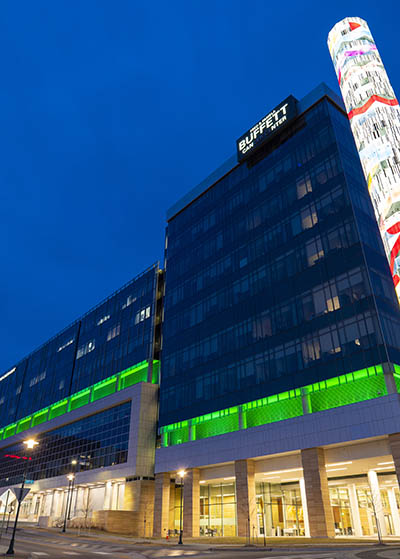 |
The Fred & Pamela Buffett Cancer Center marks Earth Day (Photo by Taylor Wilson/Nebraska Medicine) |
Why does a center focused on cancer care about the environment?
You may be surprised to know that the quality of the environment we live in can be directly correlated to our risk and incidence of cancer.
We’ve talked about the connection between sustainability and health care before; and that is why the med center works to be more sustainable. While it’s easy to understand that polluted air can increase asthma attacks or worsen bronchitis, did you know that it also increases your chances for lung cancer?
The American Cancer Society’s “Cancer Prevention Study II” followed more than 1.2 million people and found a direct correlation between air pollution and lung cancer. This is largely caused by particulate matter, small pollutants you breath in, resulting from burning coal and wood, vehicle exhaust, industrial exhaust, and even wildfires. The data is specific enough that they could track trends based on where you lived. e.g. areas with more pollution had a higher incidence of cancer. Last year a study published in the medical journal “Cancer” found that risk was specific to the county you live in. Counties ranking the worst on pollution had 9 percent more people being diagnosed with cancer.
Additionally, the International Agency for Research on Cancer (IARC) studied deaths from 2010 and found that 223,000 lung cancer deaths were caused by pollution — not smoking or second-hand smoke, just pollution. They also found that it increases the risk of bladder cancer. While the IARC had classified components of pollution as cancer-causing, this data was so compelling they classified outdoor air pollution carcinogenic.
Unfortunately, it doesn’t stop there. Another study published last year in the journal Environmental Research found that chemical exposure early in life increased risk for breast cancer diagnosis later in life. Identified chemicals include air pollution, specifically from burning wood and coal, as well as solvents used in products we purchase — gasoline and DDT.
The journal “Cell” found that aldehydes, chemicals found in glue, building materials, cosmetics, vehicle exhaust, and cigarettes, among others, may destabilize the BRCA2 gene or trigger a mutation thereby increasing the risk of cancer.
So “go green” for cancer prevention! Reduce your exposure to chemicals, be a mindful consumer, reduce pollution (don’t forget to TravelSmart), and eat your greens, too.
